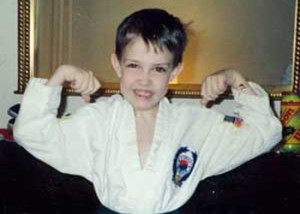Nick's Story
 In 2005, 19-year-old Nick Currey of Ridgewood, New Jersey, lost his life to Ewing sarcoma. Ewing sarcoma is a cancer most often affecting adolescents that occurs most frequently in the long bones of the legs or arms, the pelvis, chest wall, spine and the skull. It can also begin in the soft tissues.
In 2005, 19-year-old Nick Currey of Ridgewood, New Jersey, lost his life to Ewing sarcoma. Ewing sarcoma is a cancer most often affecting adolescents that occurs most frequently in the long bones of the legs or arms, the pelvis, chest wall, spine and the skull. It can also begin in the soft tissues.
Nick survived leukemia as a child - he was diagnosed at age 4 and treated for two years following - only to succumb to Ewing sarcoma as a young adult. Being a leukemia survivor may well have caused Nick to develop Ewing sarcoma. Childhood cancer survivors are nine times more likely than the general population to develop a sarcoma. In addition, the lifetime dosages of chemotherapy Nick received directly contributed to his death. His body could not survive the intense chemotherapy associated with the autologous stem cell transplant that was his last, best hope. If more targeted, less toxic therapies had been available, Nick might be alive today.
While survival rates for childhood cancer have shown impressive improvement, those statistics only capture patients who survive five or 10 years. They do not reflect the survivors, like Nick, who suffer an early death from secondary cancers or devastating long-term side effects, such as heart disease, that result from the toxicity of current therapies.

Nick's parents, Nancy and Ralph Currey, established the Nick Currey Fund in his memory to support research that will help us more quickly reach the day when no young person's life is cut short by Ewing sarcoma. Donations to the Nick Currey Fund will be used exclusively to fund pediatric cancer research projects selected by the Currey family in consultation with Michael Harris, MD, head of Pediatric Hematology and Oncology at Hackensack University Medical Center and other leading pediatric oncologists. Dr. Harris was Nick’s oncologist and close friend for 15 years.
To date, The Nick Currey Fund has raised over $1.3 million and continues to fund a number research projects aimed at improving outcomes for children, adolescents and young adults diagnosed with Ewing sarcoma.

